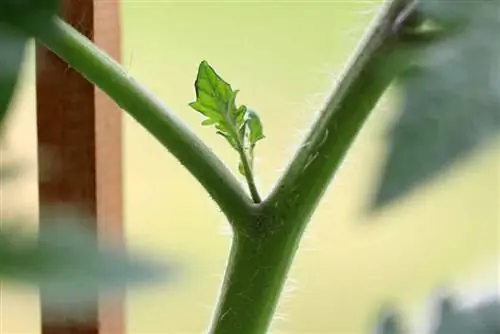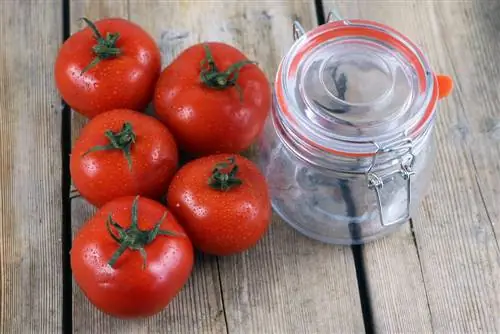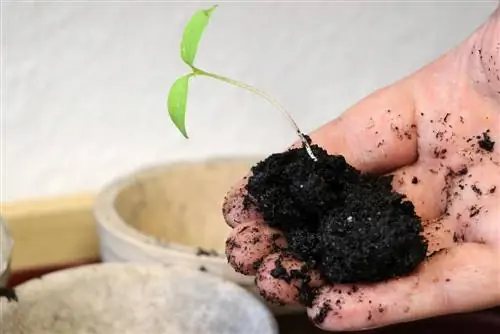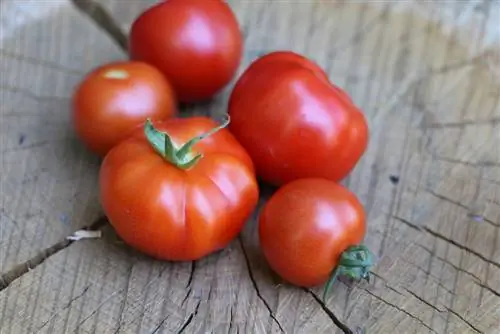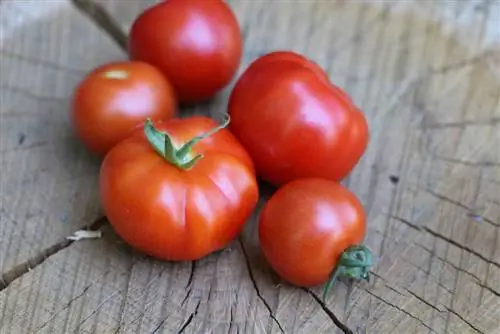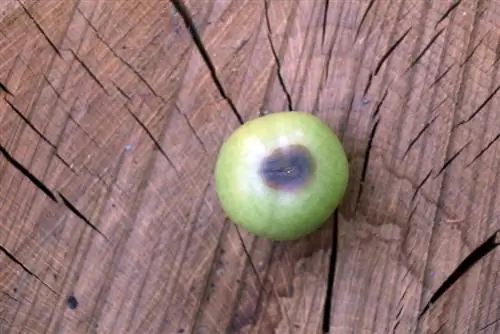- Author admin [email protected].
- Public 2023-12-17 03:39.
- Last modified 2025-01-24 12:45.
The tomato harvest is not always plentiful in our latitudes. Rain and brown rot often affect the plants. The wild growth also uses up a lot of energy, which the fruits then lack. But the so-called austerity should help against this. Those who regularly remove the energy-sapping shoots will be rewarded with a better harvest. Is that correct? If so, do you have to take anything into account?
What is austerity?
As unusual as the term may be for many, the term pinching out hides a simple measure: the removal of unwanted shoots from the tomato plant. Only special shoots are removed, which are called stingy shoots. They do not bear fruit, but they rob the tomato plant of a lot of energy that it can use for fruit production. They are therefore broken off or cut off early and regularly.
Tip:
Larger stingy shoots can be used for further propagation. After they have formed roots in a glass of water for about a week, they are planted out.
Benefits of maxing out
If a tomato plant is allowed to grow uncontrolled, it will quickly become bushy. All the greenery uses up a lot of nutrients and energy. The dense growth also promotes disease. Stripping out solves both problems.
- more energy and nutrients remain for fruit formation
- more tomatoes are forming
- Tomatoes are larger and ripen faster
- the tomato plant grows slimmer
- takes up less space
- Shoots are more airy
- Tomato plants can dry out better after rain
- The spread of fungal diseases is prevented
Tip:
The slender growth habit caused by thinning is well suited for growing tomatoes in greenhouses, where available space is usually limited.
There are also disadvantages
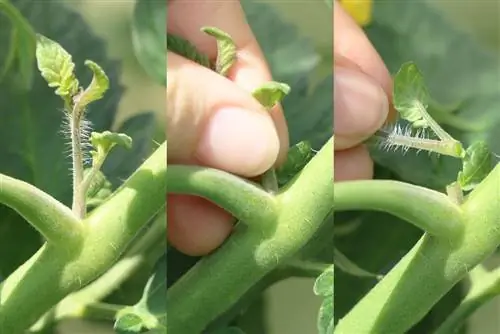
Maximizing is not only associated with advantages. On the one hand, the natural growth of the tomato plant is changed. On the other hand, breaking off or cutting off the stingy shoots creates open wounds.
- slender growth is less stable
- Wind can bend the plant
- Tethering is required
- pathogens can easily penetrate wounds
- the risk of disease increases
The high workload should not be neglected. Removing the shoots once is not enough. Newly growing stingy shoots require repeated intervention. For laypeople, there is also the risk that fruit-bearing shoots will be accidentally removed instead of the stingy shoots.
The right time
When the tomato plant is planted in the bed, the first shoots will soon sprout. The work of pruning therefore begins shortly after planting and is only over when the fruits are ready to harvest.
- Period around June to September
- until harvest
- weekly or bi-weekly
- as long as the stingy shoots are a few centimeters small
- on a dry and warm day
- ideally in the morning
Note:
A monthly interval for thinning is not recommended, as the shoots can become quite large in the meantime. The consequences would be: high loss of strength for the plants and larger wounds after thinning out.
Differentiation of shoots
The tomato plants not only form many energy-sapping shoots, but also shoots that will later bear fruit. The shoots must be clearly distinguished from each other so that the fruit-bearing shoots are not accidentally removed. This fear of removing false shoots actually stops many tomato owners from pinching. The miserliness can be easily identified.
- Avaricious shoots do not form on main shoots
- they sit in the leaf axils
- between main shoot and side shoot
- As long as they are small, they are easier to see
- larger shoots push the leaf axils apart
- this makes the distinction more difficult
Tip:
If you're trying out your tomatoes for the first time, you don't want to make any mistakes. Therefore, ask another tomato gardener who is familiar with pinching for support and guidance so that only pinching shoots are consecrated.
Cancel or cut?
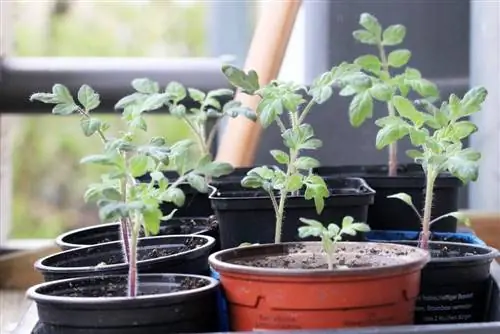
Break off stingy shoots by hand or would you rather cut them off cleanly with cutting tools? There is no clear answer to this because each method has its advantages and disadvantages. That's why every tomato gardener has to find out the right method for themselves.
- Stinginess has a simple breaking point
- especially the small shoots can be easily removed by hand
- with larger shoots there is a risk of being pulled out improperly
- Plant juice leaves stains on the skin
- Cutting tool ensures smooth interfaces that heal well
- However, this method is more complex
- Blades can cause injuries to neighboring parts of the plant
- cutting can quickly happen too close or too far from the main shoot
Tip:
In any case, miserliness should not be ignored. This means that other parts of the plant can easily tear off too. The “tattered” tear point can also heal poorly and thus increases the risk of illness.
Maximizing step by step
Pruning tools do not necessarily need to be used to prune tomatoes. The young shoots can be easily removed by hand. A knife might only be necessary if the shoots are already stronger.
- Wait for suitable weather. To ensure that the open areas heal well, the skinning should be done on a dry and warm day.
- Perform the stripping in the morning because the wounds can dry faster during the day.
- Check each shoot to see whether it really is a miserly instinct. Do this systematically from top to bottom.
- Take small, soft shoots up to about 5 cm long between your thumb and forefinger. Use your thumbnail to snip it off close to the leaf axil.
- Break off larger shoots, also close to the leaf axil. A knife can also be used for shoots that are too large.
- Leave the lowest miserliness. They give the tomato plant more stability.
- Dab the open areas with a cloth, this will speed up the healing of the wounds.
Note:
While stick tomatoes benefit from thinning, removing the shoots from bush tomatoes can cause more damage. All he althy shoots should definitely remain on the plant. Even slightly windy days are good for thinning, as the wind “blows” the moisture away from the plants and so the wounds can dry quickly.
Don't feel like making the most of it?
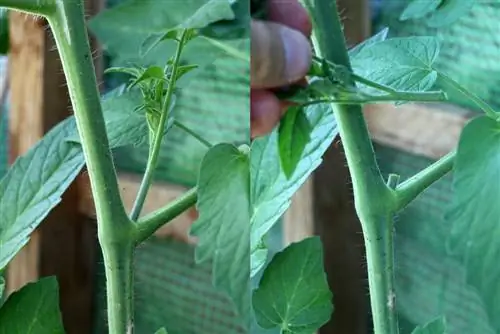
Regular and time-consuming cleaning can sometimes be annoying. Not everyone has the desire or time for it. To ensure that the tomato plants produce the desired yield without pinching, something can be done in advance.
- cool and dark location causes bushy growth
- many miserliness are the result
- therefore choose an optimal location right from the start
- pay attention to plenty of heat and light
- the tomato plant is growing upwards
- the need for paring down is reduced to a minimum.

